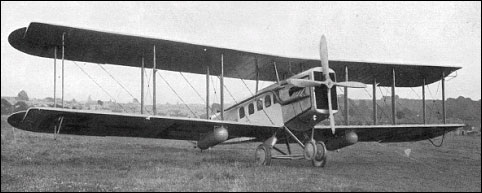 |
Westland Limousine 6 Seat1920 |  |
| SIX-SEAT COMMERCIAL CABIN BIPLANE | Virtual Aircraft Museum / United Kingdom / Westland |
 |
The second Westland venture in civil aircraft was the Six-seat Limousine, a development of the original Limousine, but much bigger, and fitted with the more powerful Napier Lion engine. It was specially produced to take part in the Air Ministry Competition for large and small commercial aeroplanes, which was held at Martlesham in the autumn of 1920. The object of the Competition was to discover the most suitable design, in each category, to replace the converted military machines then operating on the European air routes, and the various tests were devised with safety and comfort of the passengers as the main consideration. From this angle the Westland machine was ideal and Captain Keep, who flew it at Martlesham, rather shook his passengers by leaving the controls when cruising about 130km/h at 9150m, and entering the cabin for a chat and a smoke! The Limousine, meanwhile, continued on an even keel and the risk of fire was negligible, the main fuel tanks being placed well outboard beneath the lower main planes. After an exciting contest with its nearest rival, the Sopwith Antelope flown by Harry G. Hawker, the Westland entry finally won the GBP7,500 first prize in the small aeroplane class. An amusing story is told in connection with the final stage of the tests, when both the Limousine and the Antelope had secured an almost equally high number of marks and only one test remained. This was the emergency landing, and the competitors had to approach over a row of small balloons, tethered about the height of tall elms, touch down and pull up in the shortest possible distance beyond. This manoeuvre had to be performed three times, the average of the three distances from the "hedge" giving the required performance figure, the only snag being that if the machine was damaged in landing automatic disqualification followed. Keep and Hawker, with the prize within reach, were both a little anxious about this test and decided to spin a coin - with interesting results. Keep won the toss and elected to let Hawker make the first attempt. Hawker then proceeded to make two very good landings, but cut it a little fine on the third and final approach, with disastrous results to the Antelope's undercarriage. From that point the issue was never in doubt, and Keep simply went on to make his landings and to win the prize. There is little doubt, however, that the Limousine would have taken the prize in any case. Several Six-seat Limousines were built, but the original competition machine, G-EARV, had the most interesting career. It was sold to Sidney Cotton, of "Sidcot" suit fame, and used by him as a spotter with the Newfoundland sealing fleets. Piloted by Mr. T. K. Breakell, G-EARV was used in a gold-rush to a reported "strike" at Stag Bay, Labrador, where, landing on thin ice on the shore of the bay, the pilot had to keep taxying to prevent the machine sinking. A.H.Lukins "The Book of Westland Aircraft", 1943
|  COMPANY PROFILE | ||||||||||||||||||||||||||||||||||||||||||||||
 |

|

